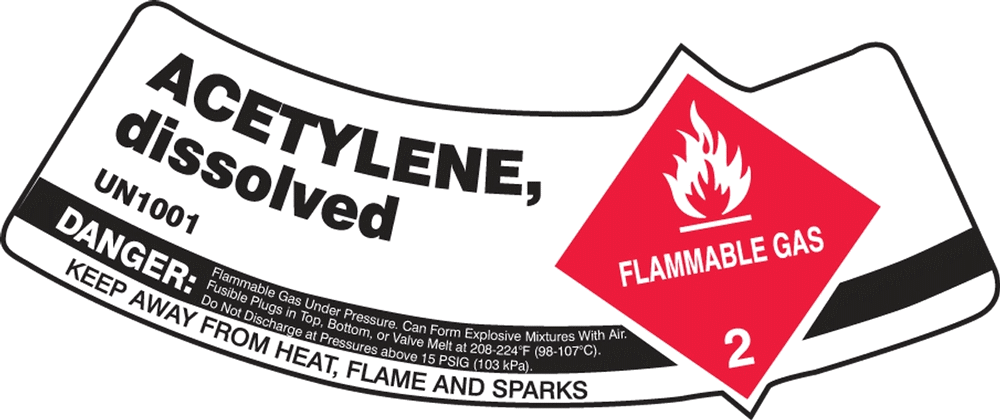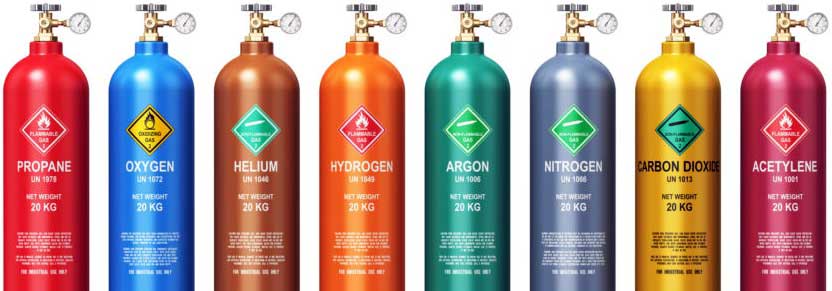
Working with acetylene cylinders
Fortunately, it is rare for acetylene-filled cylinders to be exposed to fire. But almost always such a situation leads the user to a more or less panicky state. Quite understandable, since the most wild stories circulate about the dangers of acetylene cylinders. And indeed, if such a cylinder explodes, the consequences, depending on the situation, are enormous and simply impossible to estimate in advance.
Acetylene cylinder packaging
The acetylene cylinder is an exception to other gas cylinders, because it is completely filled with a porous mass, in which acetone has been sucked up. That porous mass ensures a permanent distribution of the acetone over the entire contents.
The reason for this is, that acetylene at a pressure above about 2 bar, without the presence of air or oxygen needs to be present, at a sufficiently powerful ignition source can disintegrate under explosive phenomena into its elements, carbon and hydrogen; this is called dissociation.
If acetylene is dissolved in acetone and finely dispersed over the porous mass, a safe filling pressure of 15 bar at 15°C. Depending on the temperature, the gas pressure can vary by about 0.3 bar/°C.
Note the low ignition temperature!
Acetylene is a highly flammable gas, with an explosion range of 2.4 - 83 vol% in air. It has a low ignition temperature of 305°C, in addition to a low ignition energy of 0.02mJ.
Acetylene can therefore be ignited without an open flame or spark. A metal surface can even reach the required temperature assume, without looking "red hot"!
Therefore, when welding and soldering, for example, take into account the conduction of heat into an adjacent room where acetylene is is stored.
Some advice to avoid problems
| ↪ | Make sure your equipment is in optimal condition and meets all safety conditions, such as the mandatory use of a flame arrestor. |
| ↪ | Make sure your employees working with the equipment are familiar with it, and what procedures to follow in case of an emergency, so everyone knows what their job is. |
| ↪ | Always check in advance the rubber seal between valve and pressure regulator for any leaks, as well as all other connections. |
| ↪ | Avoid contact of acetylene with pure copper, mercury, silver and bronze with more than 64% copper. |
| ↪ | Always use an extinguisher with a capacity of at least 6kg is present, and that everyone also knows how to handle it. |
| ↪ | Use an acetylene cylinder upright, or at an inclination of at least 30°. |
| ↪ | Use only cylinder that are in good condition, within the inspection deadline and are approved and permitted in your country in terms of design. Checking the inspection period is your own responsibility; in principle, your supplier always delivers cylinders that are within the inspection period, but of course has no insight into how long this cylinder remains in your possession. |
| ↪ | Make sure you stay within the terms of your permit under the Environmental Management Act. |
| ↪ | When interrupting work, always close the valve on the gas cylinder and depressurize the low-pressure section. You are obliged to keep the key always be at hand, for example by leaving it on the valve it in place. Also, always start the work with the prescribed blow-through, leak check and safety procedure. |
| ↪ | The penetration of moisture into the cylinder must be prevented; therefore always close the valve of an empty cylinder. |
| ↪ | Remove cylinders you are not using or empty from the workshop, and put them in a responsible place. Remove the cylinders from the workshop after working hours; this may seem problematic, but becomes a lot easier if they are on a cylinder cart are. |
| ↪ | Make sure the cylinder can never fall over, but in such a way that it is easily accessible and can be moved quickly. |
| ↪ | A good cylinder battery outside, with a low-pressure line inside the workshop, is recommended over any other method of working. |

Related Post(s)

Colour coding of the most important gas cylinders in accordance with EN 1089-3 standard...

RAL colors are a system developed by the German State Commission for Supply Conditions and Quality Assurance...